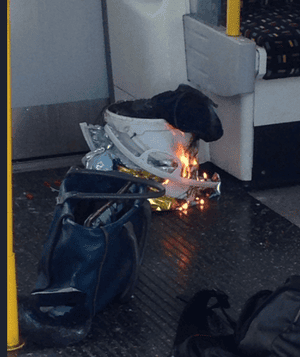London tube bombing: PM says terror threat level raised to critical
Police say bomb caused blast that sent fireball down carriage at Parsons Green station, leaving dozens injured.
‘A fireball singed my hair’: what Parsons Green witnesses saw – video report
Britain’s terror threat level has been raised from severe to critical, indicating a further attack may be imminent following the Parsons Green tube bombing, Prime Minister Theresa May has said.
A hunt was under way on Friday evening for the bomber who attempted to bring carnage to a London rush-hour tube train packed with schoolchildren and commuters.
Twenty-nine people including a young boy were injured when the bomb partially detonated and sent a ball of fire along a carriage of a District line train at Parsons Green, west London.
Police are understood to have found CCTV images that captured the bomber as he boarded the train with the bomb packed in a white plastic bucket inside a Lidl supermarket bag. The train is believed to have had onboard CCTV, and there are a large number of cameras covering the network.
Islamic State claimed responsibility for the blast, the militant group’s Amaq news agency said on Friday evening.
Nobody suffered life-threatening injuries in the incident, the fifth terrorist attack Britain has suffered in less than six months. Theresa May condemned it as cowardly and the home secretary, Amber Rudd, denounced it as “callous and indiscriminate”. The London mayor, Sadiq Khan, described the attack as hideous and added: “We will never be defeated.”
A former army bomb disposal officer told the Guardian that it appeared the initiating charge of the device had exploded, but had failed to detonate the main charge.
Initially, police had considered the possibility that the bomber had been among those taken to hospital, where many were treated for flash burns.
However investigators believe the device was remotely detonated, which suggested it may not have been intended as a suicide attack, and that the bomber may have left the train before the explosion.
Meanwhile, Donald Trump’s first response to the attack – a tweet in which he claimed the “loser terrorist” had been on Scotland Yard’s radar, and that more proactive policing was required – was dismissed by a police spokesman as “unhelpful”. May also criticised the US president, saying: “I never think it is helpful for anybody to speculate on what is an ongoing investigation.”
Another attack in London by a loser terrorist.These are sick and demented people who were in the sights of Scotland Yard. Must be proactive!
— Donald J. Trump (@realDonaldTrump) September 15, 2017
The explosion happened at about 8.20am on Friday while the train was stationary and the doors open.
Rory Rigney had just boarded the rear carriage of the train and was standing just feet away when the blast went off. “I thought, ‘Did someone smash something?’ It sounded like a smash, then I heard a scream and thought ‘it’s someone having a fight’. Then I saw the fireball coming towards me – yellow or orange. My face still feels warm.
“The doors were still open, so I jumped out and tried to get as far away as possible, got on the ground and covered myself. I wasn’t hanging around to get a better look at it.”
Chris Wildish, who was also on the train, said “a massive flash of flames” reached up to the ceiling of the train, and then the air was filled with the smell of chemicals. Many of the passengers were schoolchildren, who were knocked around by people trying to get away from the fire, he said.
Emma Stevie said people tumbled over each other as they tried to escape. “There were people on top of people. There was a pregnant lady under me shouting ‘I’m pregnant’. There was a little boy in his red and black uniform, he must have been about eight years old, a tiny thing, with his face smashed into the steps.”
Before long, a number of people returned to the train to retrieve bags and telephones. A few took photographs of the smouldering remains of the device, which had been packed into a bucket that eyewitnesses said appeared to have held mayonnaise. A number of wires, which appeared to be attached to small lights, were also visible.
Tube staff then ordered people to leave the station. Armed police were on the scene within minutes, as were firefighters and paramedics, who began treating people with burns.
Police threw a cordon around the area and asked some residents to leave their homes. Armed police evacuated a nursery and a junior school, and a girls’ secondary school was placed in lockdown.
NHS England said 29 patients had been treated, with 21 still in hospital on Friday evening.
Responsibility for the investigation was quickly handed to Scotland Yard’s counter-terrorism command. However, the joint terrorism analysis centre, which sits within MI5, decided against raising its public assessment of the terrorist threat level to critical, which would have signalled that an attack was thought to be imminent.
May said: “The threat level remains at severe. That means that a terrorist attack is highly likely. But this will be kept under review as the investigation progresses.
https://twitter.com/EmmaStevie1/status/908595323777486848
“The public should go about their daily lives but remain vigilant. People who are travelling in London will see an increased armed police presence on the transport network and security will be increased.”
The assistant commissioner, Mark Rowley, said that hundreds of detectives have been drafted in to the investigation.
Still unclear but very scary – extremely heavy armed police presence now #ParsonsGreen pic.twitter.com/WkodyNsfk0
— Alex Littlefield (@A_Littlefield) September 15, 2017
On Friday night detectives were examining a mass of CCTV footage from the underground rail network, and from businesses around some District line stations.
The device was being examined by forensics experts, and may offer clues from its construction and from the chemicals used to make the explosive charge.
Counter-terrorism investigators will want to establish where the device was put together, and where the materials to make it were acquired. They will also be attempting to establish whether the bomb-making knowledge was acquired from the plethora of DIY guides on the internet, or from another person.











